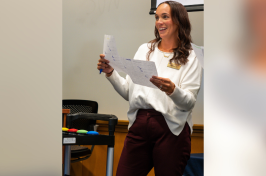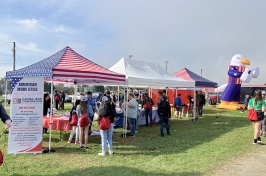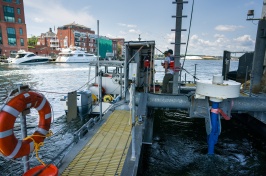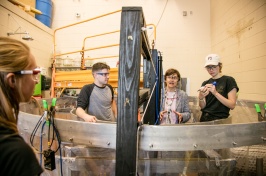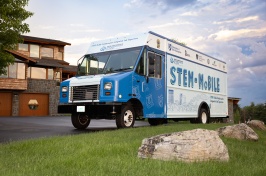Ice Core Project Coordinated by UNH Obtains Unrivaled Climate Record

Caption: The first replicate core ever taken from the high side of an ice core borehole. The curvature on the top is the original borehole. The replicate core has a diameter of 4.25 inches. Photo by Jay Johnson, IDDO, University of Wisconsin-Madison.
DURHAM, N.H. - A team of U.S. ice coring scientists and engineers in Antarctica, funded by the National Science Foundation, have recovered an unprecedented record of climate and greenhouse gases in the atmosphere that extends back 68,000 years. The core is the longest ever drilled by an American team at 11,160 feet (3,405 meters).
The West Antarctic Ice Sheet (WAIS) Divide ice core project, with science coordination by the University of New Hampshire, provides a record of uniquely detailed information on past environmental conditions such as the atmospheric concentration of greenhouse gases, surface air temperature, wind patterns, the extent of sea ice around Antarctica, and the average temperature of the ocean.
The ice containing the record was recovered at a field camp in the center of West Antarctica, 650 miles (1,040 kilometers) from the South Pole, where the ice cover is more than two miles thick (3,460 meters). By examining past climate at an annual resolution, the record will help scientists understand why climate can change abruptly (in less than 10 years) and how climate will unfold in the coming century.
When snow falls at this site it rarely melts, and builds up in thick annual layers, which are compressed into ice by subsequent snowfall. Chemicals and gases in the atmosphere that are characteristic of environmental conditions when the snow fell are trapped in the ice. The age of the ice is determined by identifying the chemical difference between winter snow and summer snow, and counting the years much like counting tree rings to determine how old a tree is.
The WAIS Divide Science Coordination Office at UNH distributes samples of the ice to more than 20 U.S. university and national laboratories that make the measurements. Most of the measurements are indicative of global conditions, not just the remote location where the ice was collected. The information from the project will be used to test and improve the predictions of how the current human-caused increases in greenhouses gases like carbon dioxide and methane are altering the Earth's climate.
Other ice coring projects have produced lower time-resolution records showing that the current level of greenhouse gases is the highest in at least 800,000 years due to the burning of fossil fuels. In the new WAIS Divide core, each of the last 30,000 years of snowfall can be identified in individual layers of ice. The ice that is between 30,000 and 68,000 years old still contains a higher time-resolution record than previous projects.
"The combination of being able to identify individual years, and new analytical methods that were not available on previous projects, will greatly improve our understanding of how past changes in greenhouse gases influenced the global climate," says chief scientist for the project Kendrick Taylor from the Desert Research Institute of Reno Nevada. "This will greatly improve predictions of how the human-caused increase of atmospheric carbon dioxide and other greenhouse gases will alter our climate."
The project required eight field seasons to collect the total length of ice core because harsh weather and the remoteness of the field site limit operations to only sixty days a year. It will take two years to complete the analysis of the ice and publish the results.
At UNH, research project manager Mark Twickler and field operations manager Joe Souney of the Earth Systems Research Center within the Institute for the Study of Earth, Oceans, and Space head up the WAIS Divide Science Coordination Office. The ice cores, Twickler notes, are five-inch diameter cylinders that are first cut into three-foot sections and then smaller samples for scientific analysis.
"After eight years of hiring field workers to collect the core, organizing logistics, workshops, data collection, and coordinating the processing of the core in Denver at the National Ice Core Laboratory, it is extremely rewarding to complete the drilling portion of this project," says Twickler.
The project's unique ice coring drill was designed and operated by the Ice Drilling Design and Operations group at the University of Wisconsin, Madison through a collaborative arrangement with the Ice Drilling Program Office. In addition to collecting the 11,160-foot (3,405 meter) ice core, a new directional drilling procedure was developed that allowed the team to drill through the wall of the main hole and collect a total of 936 feet (285 meters) of additional core from five of the most interesting time periods. This enables replication of the results and expands the suite of measurements that are made on the most interesting ice.
More information on the project can be found at the following websites:
WAIS Divide Ice Core website: http://waisdivide.unh.edu
Ice Drilling Program Office - Ice Drilling Design and Operations website: http://icedrill.org
Replicate Ice Coring System video: http://www.youtube.com/watch?v=bYYwOkwl3vQ
The University of New Hampshire, founded in 1866, is a world-class public research university with the feel of a New England liberal arts college. A land, sea, and space-grant university, UNH is the state's flagship public institution, enrolling 12,200 undergraduate and 2,300 graduate students.
-30-
Photograph to download: http://www.eos.unh.edu/newsimage/WaisDivide_lg.jpg
Caption: The first replicate core ever taken from the high side of an ice core borehole. The curvature on the top is the original borehole. The replicate core has a diameter of 4.25 inches. Photo by Jay Johnson, IDDO, University of Wisconsin-Madison.
Latest News
-
October 30, 2024
-
October 10, 2024
-
October 8, 2024
-
October 3, 2024
-
October 1, 2024








